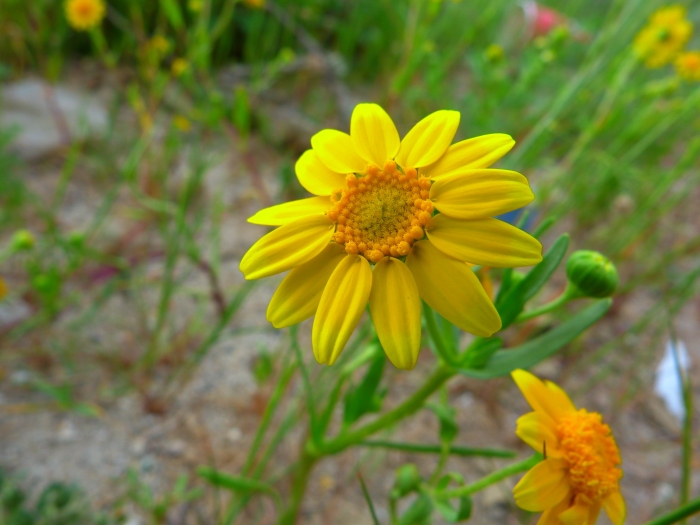Yellowray Goldfields
(Lasthenia glabrata)
Yellowray Goldfields (Lasthenia glabrata)
/
/

Zack Abbey
CC BY 4.0
Image By:
Zack Abbey
Recorded By:
Copyright:
CC BY 4.0
Copyright Notice:
Photo by: Zack Abbey | License Type: CC BY 4.0 | License URL: http://creativecommons.org/licenses/by/4.0/ | Rights Holder: Zack Abbey | Publisher: iNaturalist | Date Created: 2017-04-04T08:29:48-07:00 |
















Estimated Native Range
Summary
Lasthenia glabrata, commonly known as Yellowray Goldfields or Yellow-Ray Lasthenia, is an annual herb that thrives in vernal pools, grasslands, and coastal prairies in California and Northwest Mexico. It typically grows up to 50 cm (19.5 in) tall. The plant has a slender stem with a few pairs of oppositely-arranged, smooth-edged linear leaves, each up to 15 centimeters (5.9 inches) long. Yellowray Goldfields produce solitary or loosely clustered flower heads with 7-15 bright yellow ray florets encircling numerous disc florets, blooming from March to June. The fruit is an achene a few millimeters long, lacking a pappus. The flowers are modest in size but can create a striking display when in mass bloom.
Yellowray Goldfields are valued for their vibrant springtime display and adaptability to various soil conditions. They are often used in wildflower meadows, restoration projects, and as part of pollinator-friendly gardens. This plant is well-suited to xeriscaping due to its tolerance of low water conditions once established. It prefers full sun exposure and can adapt to a range of soil drainage types, from fast to slow. While generally low-maintenance, it can be susceptible to root rot in overly wet conditions. There are no major diseases or pests associated with this species, making it a trouble-free addition to native plant gardens.CC BY-SA 4.0
Yellowray Goldfields are valued for their vibrant springtime display and adaptability to various soil conditions. They are often used in wildflower meadows, restoration projects, and as part of pollinator-friendly gardens. This plant is well-suited to xeriscaping due to its tolerance of low water conditions once established. It prefers full sun exposure and can adapt to a range of soil drainage types, from fast to slow. While generally low-maintenance, it can be susceptible to root rot in overly wet conditions. There are no major diseases or pests associated with this species, making it a trouble-free addition to native plant gardens.CC BY-SA 4.0
Plant Description
- Plant Type: Herb
- Height: 1-2 feet
- Width: 0.2-0.6 feet
- Growth Rate: Moderate
- Flower Color: Yellow
- Flowering Season: Spring, Winter
- Leaf Retention:
Growth Requirements
- Sun: Full Sun
- Water: Low, Medium
- Drainage: Fast, Medium, Slow
Common Uses
Bee Garden, Butterfly Garden, Drought Tolerant, Edible*Disclaimer: Easyscape's listed plant edibility is for informational use. Always verify the safety and proper identification of any plant before consumption., Low Maintenance, Showy Flowers
Natural Habitat
Native to vernal pools, grasslands, and coastal prairies in California and Northwest Mexico
Other Names
Common Names: Yellow-Ray Lasthenia
Scientific Names: Lasthenia glabrata , Lasthenia glabrata var. glabrata
GBIF Accepted Name: Lasthenia glabrata Lindl.